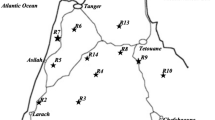Abstract
Careful assessment of the comparative diversity for molecular markers and for potentially-useful morpho-agronomic traits is paramount to the analysis of a genome through the mapping of favorable genes. Sorghum (Sorghum bicolor ssp.bicolor) varieties are traditionally classified into five races on the basis of morphological traits, especially panicle and grain traits. Isozyme diversity has provided a new insight into genetic diversity, and showed a marked geographic structure. We performed RFLP analysis on 94 varieties, chosen to represent the main cross combinations (race × geographic origin), using 35 maize probes that detect polymorphism with at least one of the two restriction enzymesHindIII andXbaI. A total of 50 polymorphic probe-enzyme combinations yielded 158 polymorphic bands. The bicolor race appeared highly variable and included many rare markers. Among the other races multivariate analysis of the data differentiated six clusters corresponding, by decreasing magnitude of divergence, to: the margaritiferum types (a sub-race of race guinea); the guinea forms from western Africa; race caudatum; race durra; race kafir; and the guinea forms from southern Africa.The apparent geographic differentiation was related to the contrasting distribution of these races and to a higher similarity between races localized in southern Africa. The data agree with the current hypotheses on sorghum domestication but reveal associations between neutral markers and traits probably highly subjected to human selection. Whether such associations will be observed with other useful traits, and to what extent they are maintained by genetic linkage, is worth exploring.
Similar content being viewed by others
References
ADDAD (1983) Manuel de référence. Association pour le Développement et la Diffusion de l'Analyse des Données. Paris
Aldrich PR, Doebley J (1992) Restriction fragment variation in thé nuclear and chloroplast genomes of cultivated and wildSorghum bicolor. Theor Appl Genet 85:293–302
Aldrich PR, Doebley J, Schertz KF, Stec A (1992) Patterns of allo zyme variation in cultivated and wildSorghum bicolor. Theor Appl Genet 85:451–460
Bennetzen JL, Melake-Berhan A (1993) Generation of a genetic map forSorghum bicolor. In: Philipps RL, Vasil IK (eds) DNA based markers in plants. Kluwer, Dordrecht (in press)
Binelli G, Gianfranceschi L, Pè ME, Taramino G, Busso C, Stenhouse J, Ottaviano E (1992) Similarity of maize and sorghum genomes as revealed by maize RFLP probes. Theor Appl Genet 84:10–16
Benzecri JA (1973) L'analyse des données. 1. La taxinomie. Dunod, Paris
Brown ADH (1989) The case for core collections. In: Brown ADH et al. (eds) The use of plant genetic resources. Cambridge University Press, Cambridge, pp 136–156
Chantereau J, Arnaud M, Ollitrault P, Nabayago P, Noyer JL (1989) Etude de la diversité morphophysiologique et classification des sorghos cultivés. L'Agron Trop 44:223–232
Cordesse F, Second G, Delseny M (1990) Ribosomal gene spacer length variability in cultivated and wild rice species. Theor Appl Genet 79:81–88
Dégremont I (1992) Evaluation de la diversité génétique et du com portement en croisement des sorghos (Sorghum bicolor L. Moench) de race guinea au moyen de marqueurs enzymatiques et morphophysiologiques. Thèse, Université Paris XI, Orsay
Dellaporta SL, Wood J, Hicks JB (1983) A plant DNA preparation. Version II. Plant Mol Biol Rep 4:19–21
De Wet IMJ (1978) Systematics and evolution ofSorghum sect.Sor ghum (Gramineae) Am I Bot 65:477–484
De Wet IMJ, Harlan JR (1971) The origin and domestication ofSorg hum bicolor. Econ Bot 25:128–135
Dice LR (1945) Measures of the amount of ecologic association between species. Ecology 26:297–302
Doggett H (1970) The history, origins and classification ofSorghum. In:Sorghum, Longmans Green, London and Harlow, UK, pp 1–48
Doggett H (1988)Sorghum. Longman, London, UK
Feinberg AP, Vogelstein B (1983) A technique for radiolabelling DNA restriction endonuclease fragments to high specific activity. Anal Biochem 132:6–13
Frankel OH, Brown ADH (1984) Current plant genetic resources — a critical appraisal. In: Genetics new frontiers. Proc XVth Int Congress Genet. Oxford and IBH publishing Co, UK, pp 1–11
Harlan JR, De Wet JMJ (1972) A simple classification of cultivated sorghum. Crop Sci 2:172–176
Harlan JR, Stemler A (1976) The races of sorghum in Africa. In: Harlan JR, De Wet JMJ, Stemler A (eds) Origins of African Plant do mestication. Mouton Press, The Hague Paris, pp 465–478
Hoisington D (1992) Laboratory protocols: CIMMYT Applied Molecular Genetic Laboratory. CIMMYT, Mexico, DF
Hulbert SH, Richter TE, Axtell JD, Bennetzen JL (1990) Genetic mapping and characterization of sorghum and related crops by means of maize DNA probes. Proc Natl Acad Sci USA 83:5554–5557
Morden CW, Doebley IF, Schertz KF (1989) Allozyme variation in old world races ofSorghum bicolor (Poaceae). Am I Bot 76:247–255
Ollitrault P (1987) Evaluation génétique des sorghos cultivés (Sor ghum bicolor L. Moench) par l'analyse conjointe des diversités enzymatique et morphophysiologique. Thèse, Université Paris XI, Orsay
Ollitrault P, Arnaud M, Chantereau I (1989). Polymorphisme enzy matique des sorghos. II. Organisation génétique et évolutive des sorghos cultivés. L'Agron Trop 44:211–222
Vavilov NI (dy1950) Phytogeographic basis of plant breeding. In: The origin variation immunity and breeding of cultivated plants. Chron Bot 13:13–54
Whitkus R, Doebley J, Lee M, (1992) Comparative genome mapping of sorghum and maize Genetics 132:1119–1130
Author information
Authors and Affiliations
Additional information
Communicated by G. E. Hart
Rights and permissions
About this article
Cite this article
Deu, M., Gonzalez-de-Leon, D., Glaszmann, J.C. et al. RFLP diversity in cultivated sorghum in relation to racial differentiation. Theoret. Appl. Genetics 88, 838–844 (1994). https://doi.org/10.1007/BF01253994
Received:
Accepted:
Issue Date:
DOI: https://doi.org/10.1007/BF01253994




